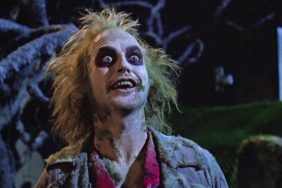There was a time when fights in movies were mostly thuggish affairs, shot at a distance by men (and usually not women) throwing telegraphed punches at each other like amateurs. It took a long time for martial arts to take off in western cinema, but once it did, the action genre was changed forever. Ornate, balletic choreography – and the types of characters who would actually devote the time and energy to master those disciplines – are now commonplace at the multiplex, and there is a rich tradition of foreign films for fans to discover as well, most of which only relatively recently became readily available on home video and instant streaming (especially in restored, high quality presentations).
With Kung Fu Panda 3 in theaters this weekend, we finally have an excuse to tackle the martial arts movie genre in Crave’s The Best Movie Ever. So this week we asked Crave’s film critics William Bibbiani and Witney Seibold, and Collider’s own Brian Formo, to pick one (and only one) film to stand for the whole martial arts genre, and represent the best it ever had to offer. Old school won out this week: all of the films they picked are established classics from Hong Kong, America or Japan.
Also: The Best Movie Ever | Creepy Dolls
Find out what they have selected as the best martial arts movie ever (some are bigger experts than others), and come back next Wednesday for an all-new, highly debatable installment of Crave’s The Best Movie Ever!
Witney Seibold’s Pick: Enter the Dragon (1973)

Warner Bros.
When it comes to martial arts films, I am woefully behind. I have no prejudice toward the genre, mind you – indeed, the few martial arts films I have seen have been pretty spectacular – but Chinese martial arts pictures have simple eluded my attention. This is particularly curious, as I actually participated in judo throughout my youth. But films about martial arts have been daunting to approach. There are too many, it seems, to find a proper entry point. As such, I have not seen such hallowed classics as Drunken Master, The 36th Chamber of Shaolin, Fists of Fury, Master of the Flying Guillotine, or Five Deadly Venoms. My experience with martial arts films skews American: The Karate Kid, Bloodsport, Redbelt, and the like. I’m very, very fond of Rumble in the Bronx.
So, as a confessed layman, I will select the most obvious choice. Enter the Dragon, the only Bruce Lee film I have seen, is the best of all martial arts films. In it, Lee plays Lee, a martial artist who must infiltrate the crime lair of an evil claw-handed end-boss named Han (Shih Kien), by posing as a competitor in Han’s annual fight tourney. The setup is the stuff of preadolescent legend: Gather together a group of ragtag awesome guys (in this case, include Richard Roundtree and John Saxon), and have them alternately fight each other, and, eventually, a bunch of bad guys. This is the way a 7-year-old boy plays with his toys, and there’s something wonderful and primal in that. That playfulness is then accompanied by some of the greatest fight choreography in a movie.
What’s more, Enter the Dragon propels Bruce Lee almost instantly into legend status by making him so – there’s no other word for it – badass. He is muscular, lithe, and moves like Fred Astaire with nunchucks. He always looks mean and tough. Few watching Enter the Dragon have escaped unmarked.
William Bibbiani’s Pick: The 36th Chamber of Shaolin (1978)

Shaw Bros. Studio
I fell in love with the martial arts movie genre at San Diego Comic-Con, at Ric Meyers’ annual Superhero Kung-Fu Extravaganza, where he screened the oddball Sammo Hung flick The Victim. It wasn’t just that the film was strange and funny and full of great action, it was the enthusiasm with which Meyers spoke about the genre, and the rich history I had yet to learn about. I consumed as many old and new-school kung fu films I could get my hands on. I bought books about the subject. I never found a sifu of my own, but I hope I do someday. I love kung fu, and I love kung fu movies.
There are many great films that are contenders for the title of “The Best Martial Arts Movie Ever,” but I knew that whatever I picked, it would be directed by Lau Kar-leung (also written as “Liu Chia-liang”). If you want to see how this genre works, start here folks. Dirty Ho, Legendary Weapons of China and Executioners from Shaolin are all timeless classics. But The 36th Chamber of Shaolin is what it’s all about: it’s a fascinating drama about self-improvement through kung fu, and the responsibilities of turning your body into a weapon.
The legendary Gordon Liu stars as the even more legendary San Te, a rebel against the Manchurian government who is forced to seek refuge at the Shaolin Temple, where he spends many years becoming a kung fu master by working his way through 35 – and only 35 – chambers, each one containing a new challenge. Carrying buckets up a hill with knives strapped to your arms, so you cannot lower them. Walking (more or less) on water. And once he finally reaches the final chamber, he announces his plan for a 36th, which puts him at odds with his fellow monks and sends him back out into the world, where he puts his kung fu mastery to good use.
The 36th Chamber isn’t full of wall-to-wall action, but it’s full of wall-to-wall kung fu: the discipline and mental prowess necessary to achieve one’s pinnacle, and the strength of will necessary to use one’s strength’s properly. But don’t worry, the fights kick ass too. It’s the best martial arts movie ever, and specifically the best kung fu movie ever, and one of my favorite and most personally influential films.
Brian Formo’s Pick: Shogun Assassin (1980)

Toho
“Motion pictures are the art form of the 20th century, and one of the reasons is because they are a slightly corrupted art form,” the great indie producer Roger Corman once said. “They combine art and business.” I’m quoting Corman, because he did distribute my pick for best martial arts film, Shogun Assassin, but also because it does feel kinda cheap to choose this “Robert Houston” film, but hey, that’s business. And you know what? As a Greatest Hits film, Shogun Assassin is more polished, brighter, funnier and more breakneck than the first two Lone Wolf and Cub films that it combines, reassembles, and remixes. It’s fitting that this is a film that had multiple lives, first as a grindhouse late night staple, then as a constant source of sampling for members of the Wu-Tang Clan, and now as a Quentin Tarantino hat-tip—because it itself is a glorious Frankenstein film of remix fun.
So what is Shogun Assassin? A producing protege of Otto Preminger and Andy Warhol, David Weisman, bought the rights to the first two Lone Wolf samurai films (from a series of six) for $50,000. A new score was produced, color was corrected, new dialogue was written (by deaf lip-reading writers who attempted to match English words to dub over the dialogue), and new narration was written for both the child narrator and the warriors who desired to hear certain sounds emit from human skin that suffered precise sword cuts. All told, 164 minutes were trimmed down to a tight, rousing 89-minute film.
I’m not someone who needs short films (hell, one of my favorite films of 2015 was a six-hour Portuguese film about the European economy and wind wizards), but Shogun Assassin doesn’t leave out many of the emotional beats that are languidly introduced in the Cub series. It lets you understand the warrior father and young child’s bond and gets to the next fight sooner. And when there is a fight, the more precise editing of Shogun makes the fight more absurd and fun. How? Quicker cuts that produce “a sound like wailing winter winds.” And to have it happen in a remix film is… ridiculously fun.
Top Photo: Shaw Bros. / Warner Bros. / Toho
Previously on The Best Movie Ever:
The Best Movie Ever
-
The Best Movie Ever | Under the Sea

Is the best movie ever set underwater a family film about a fish or a World War II movie about a German submarine?
Photos: Disney / Pixar / Neue Constantin Film
-
The Best Movie Ever | Video Game Adaptations

There aren't a lot of good video game adaptations, and our critics just can't agree on which one is the best.
Photos: Universal Pictures / New Line Cinema / Dimension Films
-
The Best Movie Ever | Reptiles

Movies about slithery things aren't very common, so our critics are presenting their picks for the best reptile movies ever.
Photo: Warner Bros. / Paramount Pictures / New Line Cinema
-
The Best Movie Ever | Helena Bonham Carter

Is Helena Bonham Carter's best movie a classy costume drama or a twisted critique of contemporary masculinity?
Photo: Fine Line Features / Miramax Films / 20th Century Fox
-
The Best Movie Ever | Crime Comedies

What's the best comedy ever made about living a life of crime? Our critics present their picks.
Photo: MGM / Warner Bros. / Janus Films
-
The Best Movie Ever | Jodie Foster

The Oscar-winning actor/director is one of the most respected artists in the film industry. But what's her best movie ever?
Photo: Columbia Pictures / Warner Bros. / MGM Home Entertainment
-
The Best Movie Ever | Robert Downey Jr.

The man who would be Iron Man has had one of the most unusual careers in film history, but which movie is his best?
Photo: Warner Bros. Pictures / Paramount Pictures
-
The Best Movie Ever | Cats

Keanu may be a great comedy about a cat, but what's the best cat movie ever? Our critics picked some WEIRD films this week!
Photo: Drafthouse Films / United Artists / Kindai Eiga Kyokai
-
The Best Movie Ever | Charlize Theron

Is Charlize Theron's best movie the one that earned her an Oscar, or the one that kicked ass?
Photo: Warner Bros. / Newmarket Films
-
The Best Movie Ever | Ice Cube

It's been 25 years since Ice Cube made his acting debut. So what's his best movie ever?
Photo: Miramax Films / New Line Cinema / Universal Pictures
-
The Best Movie Ever | Dreams

What's the best movie ever made about dreams, dreaming or dreaminess? Our critics present their picks.
Photo: Films du Losange / Criterion / Fox Searchlight
-
The Best Movie Ever | Batman

Everybody loves Batman, but what's the best Batman movie ever? Our critics can't agree in this week's roundup.
Photo: 20th Century Fox / Warner Bros.
-
The Best Movie Ever | Superman

Batman v Superman isn't the best Superman movie ever, so we asked our stable of critics to decide which one is.
Photo: Warner Bros.
-
The Best Movie Ever | Justice

Let's celebrate this exciting new Dawn of Justice with a spirited debate about the best movie ever made about justice itself.
Photo: Koch-Lorber / 20th Century Fox / United Artists
-
The Best Movie Ever | John Goodman

The star of 10 Cloverfield Lane has had an astounding career, but what's his best movie ever?
Photo: Gramercy Pictures / 20th Century Fox
-
The Best Movie Ever | Die Hard Ripoffs

Die Hard spawned a whole genre of action movies that live on to this day, but which Die Hard ripoff is the best?
Photo: 20th Century Fox / Columbia Pictures / Golden Princess Film Production
-
The Best Movie Ever | Oscar Bait

'Oscar bait' isn't an insult, it's a genre. So what's the best Oscar bait movie ever?
Photo: The Weinstein Company / Universal Pictures
-
The Best Movie Ever | Witchcraft

What's the most bewitching movie ever made about witches? Our panel of critics narrows it down to two classic films.
Photo: Criterion / American International
-
The Best Movie Ever | Action Comedies

If Deadpool isn't the best action comedy ever, what is? Our panel of film critics make the case for their favorites.
Top Photo: Warner Bros. / RM Films International / 20th Century Fox
-
The Best Movie Ever | George Clooney

Everyone loves George Clooney, but none of our critics can agree on which film qualifies as his very best.
Photo: Buena Vista / Universal / Warner Bros.
-
The Best Movie Ever | Martial Arts

Our panel of critics fights over their picks for the best martial arts movie ever made. There can be only one!
Top Photo: Shaw Bros. / Warner Bros. / Toho
-
The Best Movie Ever | Creepy Dolls

Everyone's frightened of little toy people, but what's the creepiest creepy doll movie ever?
Top Photo: Universal Pictures / United Artists / New World Pictures
-
The Best Movie Ever | Modern Warfare

If 13 Hours isn't the best movie about our contemporary wars, what is? Our panel of critics weighs in.
Photo: Warner Bros./Columbia Pictures/Summit Entertainment
-
The Best Movie Ever | Revenge

If The Revenant isn't the greatest revenge movie, what is? Our film critics nominate some of the best films ever made.
Top Photos: Janus Films / Paramount Pictures / Tartan Films
-
The Best Movie Ever | Parties

We asked our critics to pick the best party movie ever made, and none of them picked a film about a frat house.
Photo: Warner Bros. / 20th Century Fox / Sony Pictures Classics
-
The Best Movie Ever | Quentin Tarantino

Is the Hateful Eight director's best film an autumnal romance or a World War II drama? Our critics can't decide.
Photos: The Weinstein Company / Miramax
-
The Best Movie Ever | Star Wars

Is A New Hope better than The Empire Strikes Back? Our critics debate the classics (and ignore the rest).
Photos: Disney / LucasFilm
-
The Best Movie Ever | Ron Howard

He's directed films in nearly every genre and won an Oscar for his troubles, but what's the best Ron Howard movie ever?
Photo: Touchstone / Universal / MGM
-
The Best Movie Ever | William Shakespeare

He's the most adapted author in movie history, but which William Shakespeare movie is the very best?
Photo: Top Photos: Toho / Paramount / Columbia
-
The Best Movie Ever | Pixar

Everyone has their favorite Pixar movie, but which one is the best?
Photo: Disney
-
The Best Movie Ever | Young Adult

Before you say goodbye to The Hunger Games, find out what our critics think was the best young adult movie ever.
Photo: Universal Pictures / Warner Bros.
-
The Best Movie Ever | Angelina Jolie

She's been acting for decades, directing for years, and winning our admiration forever. But what is Angelina Jolie's best film ever?
Photo: The Samuel Goldwyn Company / HBO / Columbia Pictures
-
The Best Movie Ever | James Bond

It's new school versus old school! Our critics debate which film qualifies as the best Bond movie ever.
Photo: MGM / Colombia Pictures / United Artists
-
The Best Movie Ever | Sandra Bullock

Our critics can only agree on one thing: the best Sandra Bullock movie isn't the one that got her an Oscar.
Photo: 20th Century Fox / Warner Bros.








